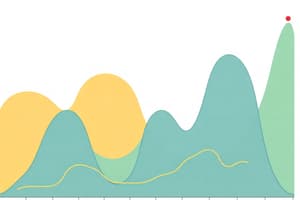Podcast
Questions and Answers
What is the purpose of a line plot?
What is the purpose of a line plot?
- To compare the sizes of different insects
- To show how many times something has happened (correct)
- To find the average length of all insects
- To categorize insects by their species
What is the first step in creating a line plot?
What is the first step in creating a line plot?
- Measure the length of each insect (correct)
- Count how many insects are in each measurement group
- Create a number line with the measurements
- Represent each bug as an 'X' above the size of the insect
What do the 'X's represent in a line plot?
What do the 'X's represent in a line plot?
- The measurement values
- The number of insects in each group
- The scale of the number line
- The individual insects being measured (correct)
How do we add the lengths of two bugs together that do not have a common denominator?
How do we add the lengths of two bugs together that do not have a common denominator?
What is the least common denominator (LCD) of the fractions 1/2 and 1/6?
What is the least common denominator (LCD) of the fractions 1/2 and 1/6?
How many bugs measure 1/2 inch in the given example?
How many bugs measure 1/2 inch in the given example?
What is the result of adding the lengths of Bug H and Bug I?
What is the result of adding the lengths of Bug H and Bug I?
What is the purpose of finding the least common denominator (LCD) when adding fractions?
What is the purpose of finding the least common denominator (LCD) when adding fractions?
How many bugs measure 1/4 inch in the given example?
How many bugs measure 1/4 inch in the given example?
What is the result of converting 1/2 to have a denominator of 6?
What is the result of converting 1/2 to have a denominator of 6?
Flashcards are hidden until you start studying
Study Notes
Line Plots
- A line plot is a graph used to count and visualize multiple data points, often used with small groups of numbers.
- Line plots are useful for showing how many times something has happened, such as measuring the length of insects.
Creating a Line Plot
- Start by creating a number line with the unique measurements from the data points (e.g., 1/8, 1/4, 1/6, 1/3, and 1/2).
- Represent each data point as an 'X' above its corresponding measurement on the number line.
Interpreting a Line Plot
- A line plot allows us to easily see the frequency of each measurement, such as how many bugs are a certain length.
Adding Measurements
- To add the measurements of two bugs together, we need to find a common denominator or least common multiple (LCM) if they don't already share one.
- Once we have a common denominator, we can add the fractions together, and simplify the result if possible.
Subtracting Measurements
- To subtract the measurements of two bugs, we need to find a common denominator or least common multiple (LCM) if they don't already share one.
- Once we have a common denominator, we can subtract the fractions, and simplify the result if possible.
Studying That Suits You
Use AI to generate personalized quizzes and flashcards to suit your learning preferences.




